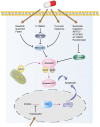Advancements in therapeutic drugs targeting of senescence
- PMID: 33133476
- PMCID: PMC7576933
- DOI: 10.1177/2040622320964125
Advancements in therapeutic drugs targeting of senescence
Abstract
Aging leads to a high burden on society, both medically and economically. Cellular senescence plays an essential role in the initiation of aging and age-related diseases. Recent studies have highlighted the therapeutic value of senescent cell deletion in natural aging and many age-related disorders. However, the therapeutic strategies for manipulating cellular senescence are still at an early stage of development. Among these strategies, therapeutic drugs that target cellular senescence are arguably the most highly anticipated. Many recent studies have demonstrated that a variety of drugs exhibit healthy aging effects. In this review, we summarize different types of drugs promoting healthy aging - such as senolytics, senescence-associated secretory phenotype (SASP) inhibitors, and nutrient signaling regulators - and provide an update on their potential therapeutic merits. Taken together, our review synthesizes recent advancements in the therapeutic potentialities of drugs promoting healthy aging with regard to their clinical implications.
Keywords: advancement; drug; healthy aging; senescence; senolytics.
© The Author(s), 2020.
Conflict of interest statement
Conflict of interest statement: The authors declare that there is no conflict of interest.
Figures




Similar articles
-
Senolytics and senomorphics: Natural and synthetic therapeutics in the treatment of aging and chronic diseases.Free Radic Biol Med. 2021 Aug 1;171:169-190. doi: 10.1016/j.freeradbiomed.2021.05.003. Epub 2021 May 12. Free Radic Biol Med. 2021. PMID: 33989756 Review.
-
The power of proteomics to monitor senescence-associated secretory phenotypes and beyond: toward clinical applications.Expert Rev Proteomics. 2020 Apr;17(4):297-308. doi: 10.1080/14789450.2020.1766976. Epub 2020 May 19. Expert Rev Proteomics. 2020. PMID: 32425074 Free PMC article. Review.
-
Independent Roles of Estrogen Deficiency and Cellular Senescence in the Pathogenesis of Osteoporosis: Evidence in Young Adult Mice and Older Humans.J Bone Miner Res. 2019 Aug;34(8):1407-1418. doi: 10.1002/jbmr.3729. Epub 2019 Jun 21. J Bone Miner Res. 2019. PMID: 30913313 Free PMC article.
-
Senescent cells as a target for anti-aging interventions: From senolytics to immune therapies.J Transl Int Med. 2025 Mar 19;13(1):33-47. doi: 10.1515/jtim-2025-0005. eCollection 2025 Feb. J Transl Int Med. 2025. PMID: 40115034 Free PMC article.
-
Cellular Senescence: A Translational Perspective.EBioMedicine. 2017 Jul;21:21-28. doi: 10.1016/j.ebiom.2017.04.013. Epub 2017 Apr 12. EBioMedicine. 2017. PMID: 28416161 Free PMC article. Review.
Cited by
-
Use of the senolytics dasatinib and quercetin for prevention of pelvic organ prolapse in a mouse animal model.Aging (Albany NY). 2024 Sep 26;16(19):12685-12696. doi: 10.18632/aging.206120. Epub 2024 Sep 26. Aging (Albany NY). 2024. PMID: 39331015 Free PMC article.
-
Understanding Molecular Mechanisms of Phenotype Switching and Crosstalk with TME to Reveal New Vulnerabilities of Melanoma.Cells. 2022 Mar 29;11(7):1157. doi: 10.3390/cells11071157. Cells. 2022. PMID: 35406721 Free PMC article. Review.
-
Metformin Beyond Diabetes: A Precision Gerotherapeutic and Immunometabolic Adjuvant for Aging and Cancer.Cancers (Basel). 2025 Jul 25;17(15):2466. doi: 10.3390/cancers17152466. Cancers (Basel). 2025. PMID: 40805165 Free PMC article. Review.
-
Donor and Recipient Age-Mismatches: The Potential of Transferring Senescence.Front Immunol. 2021 Apr 28;12:671479. doi: 10.3389/fimmu.2021.671479. eCollection 2021. Front Immunol. 2021. PMID: 33995411 Free PMC article. Review.
-
PTEN: A Novel Diabetes Nephropathy Protective Gene Related to Cellular Senescence.Int J Mol Sci. 2025 Mar 27;26(7):3088. doi: 10.3390/ijms26073088. Int J Mol Sci. 2025. PMID: 40243723 Free PMC article.
References
Publication types
LinkOut - more resources
Full Text Sources

